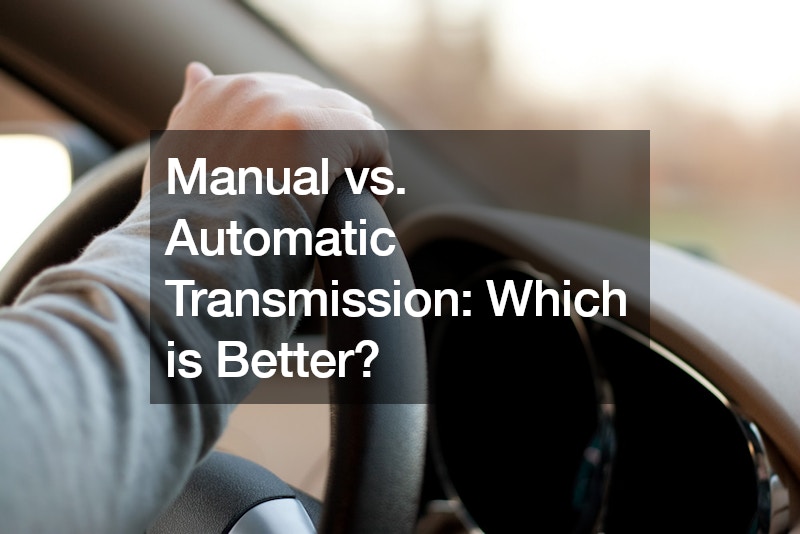Manual vs. Automatic Transmission Which is Better?

When it comes to choosing between a manual and an automatic transmission for your vehicle, the decision often sparks a heated debate among car enthusiasts and everyday drivers alike. Each transmission type has its own set of advantages and drawbacks, making the choice a matter of personal preference and driving needs. Let’s delve into the key differences between manual and automatic transmissions to help you make an informed decision.
Understanding Transmission Basics
Both manual and automatic transmissions serve the essential function of transferring power from the engine to the wheels, enabling your vehicle to move. However, they operate on different principles and configurations.
A manual transmission relies on a gear pair system, where the driver manually shifts gears using a clutch pedal and gearstick. On the other hand, an automatic transmission utilizes a planetary gear set arrangement and shifts gears automatically based on driving conditions, without requiring driver intervention.
Manual Transmission: Simplicity and Control
Manual transmissions are praised for their simplicity and direct control over gear changes. They typically have fewer components compared to automatic transmissions, making them easier to repair and maintain. For enthusiasts who enjoy the driving experience and want full control over their vehicle’s performance, manual transmissions offer an engaging and tactile connection with the car.
Automatic Transmission: Convenience and Comfort
Automatic transmissions, on the other hand, prioritize convenience and comfort. With no need for manual gear shifting, drivers can focus more on the road ahead, especially in heavy traffic or urban environments. Automatic transmissions provide smooth and seamless gear changes, offering a more relaxed driving experience for those who prefer ease of use over manual control.
Comparing Driving Experience
The driving experience with manual and automatic transmissions differs significantly. Manual transmissions often appeal to drivers seeking a more involved and spirited driving experience, as they allow for precise control over gear selection and engine RPM. However, manual transmissions require mastering the clutch and gearshift coordination, which can be challenging for some drivers, especially beginners.
On the other hand, automatic transmissions offer a more effortless driving experience, particularly in stop-and-go traffic or hilly terrain where frequent gear changes are necessary. The absence of a clutch pedal simplifies driving for many drivers, allowing them to focus on other aspects of driving, such as navigation and road awareness.
Maintenance and Durability
From a maintenance standpoint, manual transmissions are generally considered more durable and easier to repair than automatic transmissions. Manual transmission components are less complex and typically require less frequent servicing. Additionally, manual transmissions are often preferred in heavy-duty applications, such as trucks, due to their robustness and reliability.
However, automatic transmissions have evolved significantly over the years, with modern designs incorporating advanced technology to improve durability and efficiency. While automatic transmissions may require more specialized knowledge and equipment for repairs, they offer the convenience of hands-free operation and adaptive shifting algorithms that optimize performance based on driving conditions.
Fuel Efficiency and Performance
In terms of fuel efficiency, manual transmissions have traditionally held an edge over automatic transmissions. The direct mechanical connection between the engine and wheels in manual transmissions can result in better fuel economy, especially in highway driving conditions. Additionally, manual transmissions allow drivers to optimize gear selection for maximum efficiency, enhancing fuel-saving potential.
Nevertheless, advancements in automatic transmission technology, such as continuously variable transmissions (CVTs) and dual-clutch transmissions (DCTs), have narrowed the gap in fuel efficiency between manual and automatic transmissions. Modern automatic transmissions feature adaptive shift algorithms and multiple gear ratios to optimize fuel economy while maintaining smooth performance.
Driving in Different Conditions
Another factor to consider is how each transmission performs in various driving conditions. Manual transmissions offer more control over gear selection, making them suitable for driving in snow, off-road terrain, or towing situations where precise power delivery is necessary. However, automatic transmissions excel in stop-and-go traffic, hilly terrain, and urban environments, where frequent gear changes are common. Understanding how each transmission type handles different driving conditions can help you choose the one that best suits your lifestyle and driving needs.
Choosing the Right Transmission
Ultimately, the decision between a manual and automatic transmission boils down to personal preference, driving habits, and intended use. Drivers who prioritize control, engagement, and fuel efficiency may prefer manual transmissions, while those seeking convenience, comfort, and ease of use may opt for automatic transmissions.
Before making a decision, consider factors such as your daily driving environment, traffic conditions, maintenance preferences, and long-term driving goals. Consulting with a trusted mechanic or automotive expert can provide valuable insights into the pros and cons of each transmission type, helping you make the best choice for your driving needs.
In conclusion, both manual and automatic transmissions have their merits and drawbacks, and there is no definitive answer to which is better. It ultimately comes down to individual preferences and priorities. Whether you prefer the tactile feel of shifting gears or the convenience of automatic operation, choosing the right transmission can enhance your driving experience and enjoyment on the road.
.

